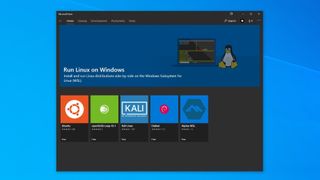Linux on Windows 10 gets major computing boost
Microsoft is adding support for Linux GUI apps along with GPU hardware acceleration

Running Linux on Windows 10 is about to get a whole lot easier as Microsoft is making a number of improvements to its Windows Subsystem for Linux (WSL) including GUI app support and GPU hardware acceleration.
Later this month, the software giant will add a full Linux kernel to Windows 10 with the release of version 2 of WSL and the company also now plans to support Linux GUI apps that can run alongside regular Windows apps.
Windows users will no longer have to use X11 forwarding to run Linux GUI apps though the updates are primarily designed for developers who want to run Linux integrated development environments (IDE) while still working in Windows.
- Microsoft admits it was wrong about Linux and open source
- Microsoft reveals new code integrity feature for Linux
- These are the best Linux apps of 2020
GPU hardware acceleration
Running Linux GUI apps within Linux used to only be possible by using a third-party X server though poor graphics performance has always been an issue. However, Windows 10 will soon get added support for GPU hardware acceleration with Linux tools. This will be particularly useful for developers working with parallels computation or training machine learning or AI models.
In a blog post, partner developer lead at Microsoft, Steve Pronovost provided more details on GPU hardware acceleration in Windows will work, saying:
“Applications running inside of the Linux environment have the same access to the GPU as native applications on Windows. There is no partitioning of resources between Linux and Windows or limit imposed on Linux applications. The sharing is completely dynamic based on who needs what. There are basically no differences between two Windows applications sharing a GPU versus a Linux and a Windows application sharing the same GPU. If a Linux application is alone on a GPU, it can consume all its resources!”
Microsoft plans to share additional details on when Linux GUI app support will be generally available later this year though Windows 10 Insiders in the Fast Ring will be able to test out GPU hardware acceleration in the next few months.
Are you a pro? Subscribe to our newsletter
Sign up to the TechRadar Pro newsletter to get all the top news, opinion, features and guidance your business needs to succeed!
Switching between Windows and Linux can be a burden for developers which is why Microsoft is providing them with all the tools and features they need to run both operating systems simultaneously.
- Also check out our guide to the best Linux distros
Via The Verge
After working with the TechRadar Pro team for the last several years, Anthony is now the security and networking editor at Tom’s Guide where he covers everything from data breaches and ransomware gangs to the best way to cover your whole home or business with Wi-Fi. When not writing, you can find him tinkering with PCs and game consoles, managing cables and upgrading his smart home.

